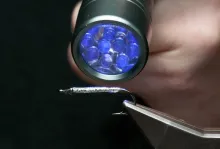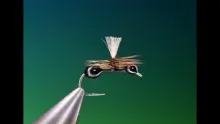When reading this book, you get the impression that the authors are proud of their work and they know that they have written an above-standard-book.
Updated or edited 9 months ago
When reading this book, you get the impression that the authors are proud of their work and they know that they have written an above-standard-book. They are not afraid of showing it, not afraid of challenging traditional tying techniques. Some may find that provoking, but what if the book can withstand this pressure...?
The title Pop Fleyes is not a typo, and it is not the synonym for one or both of the authors. The unusual title is the result of combination of the names and one of the major parts in Bob Popovics' designs — the eyes.
It was the title, which caught me the first time I saw the book at the Fly Fair 2001 in Kolding in Denmark, and it put a wry smile on my face. My smile grew even broader, when I browsed through the pages. The photographs are absolutely excellent. The step-by-step photos are illustrative and so are the drawings, which are used when a photo is not sufficient.
This is a work, which has something new on the program, and which has a lot of inspiration to the reader. Many of the flies are designed for fishing more or less tropical species in the American saltwater, but by scale, adjust the colours etc. and you have the basics for an impressive fly box for other and maybe colder waters — like the Scandinavian ones.
The book certainly emphasizes the fact that Bob Popovics has been experimenting with epoxy and silicone for many years, and must have been a leader in this field. He has developed several methods of forming the different kinds of glue before they hardened and thereby created highly durable, translucent baitfish imitations.
The nucleus in the fly designs is that they all have come up as a result of solving a problem or answering a question. In the very beginning of Popovics' experimenting, he had trouble getting materials, which had the right specifications. By gaining access to new and more suitable materials, Bob refined his flies and techniques and adjusted them in agreement with his observations, which lead to better imitations.
To spare the readers from using insufficient materials, chapter two goes through a selection their properties. In this way the authors open prepare the road of make flies, which follow their guidelines:
- Ease of construction
- Durability
- Castability
- Resistance from fouling
- Profile/shape
- Incorporation of prominent identifiable features of the natural, including action
- Consideration of where in the water column the fly will be used
Chapter three takes you through the process of using epoxy and you are quickly guided into the first tying sequence. Each of the flies presented represents a technique or special ability. The sequences are build up along a series of phots accompanied by describing texts.
Tying or fishing tips, drawings or a more detailed introduction complete some of the parts and flies. Each series ends with a photo of the finished fly and the text says in which scale the fly is shown. A great detail among many!
After a going through epoxy, Chapter four takes us to silicone flies — siliclones Here silicone is combined with sheep fleece and show how flies — after some "tailoring" — may compete with ordinary plugs and wobblers!
It is also clearly shown how to add a more 3-dimensional shape to your flies.
The final chapter goes through other designs and possibilities.
When you turn the last page, you are left with a lot of inspiration and ideas to continue out of the tangent of innovation.
- Log in to post comments







